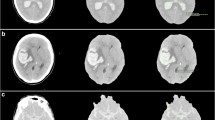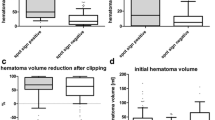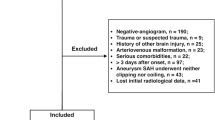Abstract
Background
In aneurysmal subarachnoid hemorrhage (SAH), clot volume has been shown to correlate with the development of radiographic vasospasm (VS), while the role of cerebrospinal fluid (CSF) volume remains largely elusive in the literature. We evaluated CSF volume as a potential surrogate for VS in addition to SAH volume in this retrospective series.
Patients and Methods
From a consecutive cohort of aneurysmal SAH (n= 320), cases were included when angiographic evaluation for VS was performed (n= 125). SAH and CSF volumes were volumetrically quantified using an algorithm-assisted segmentation approach on initial computed tomography after ictus. Association with VS was analyzed using regression analysis. Receiver operating characteristic (ROC) curves were used to evaluate predictive accuracy of volumetric measures for VS and to identify cutoffs for risk stratification.
Results
Among 125 included cases, angiography showed VS in 101 (VS+), while no VS was observed in 24 (VS−) cases. In volumetric analysis, mean SAH volume was significantly larger (26.8 ± 21.1 ml vs. 12.6 ± 12.2 ml, p= 0.001), while mean CSF volume was significantly smaller (63.0 ± 31.2 ml vs. 85.7 ± 62.8, p= 0.03) in VS+ compared to VS− cases, respectively. The absence of correlation for SAH and CSF volumes (Pearson R − 0.05, p= 0.58) indicated independence of both measures of the subarachnoid compartment, which was a prerequisite for CSF to act as a new surrogate for VS not related to SAH. Regression analysis confirmed an increased risk of VS with increasing SAH (OR 1.06, 95% CI 1.02–1.11, p= 0.006), while CSF had a protective effect toward VS (OR 0.99, 95% CI 0.98–0.99, p= 0.02). SAH/CSF ratio was also associated with VS (OR 1.03, 95% CI 1.01–1.05, p= 0.015). ROC curves suggested cutoffs at 120 ml CSF and 20 ml SAH for VS stratification. Combination of variables improved stratification accuracy compared to use of SAH alone.
Conclusion
This study provides a proof of concept for CSF correlating with angiographic VS after aneurysmal SAH. Quantification of CSF in conjunction with SAH might enhance risk stratification and exhibit advantages over traditional scores. The association of CSF has to be corroborated for delayed cerebral ischemia to further establish CSF as a surrogate parameter.






Similar content being viewed by others
References
Rabinstein AA, Lanzino G, Wijdicks EFM. Multidisciplinary management and emerging therapeutic strategies in aneurysmal subarachnoid haemorrhage. Lancet Neurol. 2010;9:504–19.
Rinkel GJE, Algra A. Long-term outcomes of patients with aneurysmal subarachnoid haemorrhage. Lancet Neurol. 2011;10:349–56.
Frontera JA, Fernandez A, Schmidt JM, Claassen J, Wartenberg KE, Badjatia N, et al. Defining vasospasm after subarachnoid hemorrhage. Stroke. 2009;40:1963–8.
Harrod CG, Bendok BR, Batjer HH. Prediction of cerebral vasospasm in patients presenting with aneurysmal subarachnoid hemorrhage: a review. Neurosurgery. 2005;56:633–54.
Le Roux PD, Elliott JP, Eskridge JM, Cohen W, Winn HR. Risks and benefits of diagnostic angiography after aneurysm surgery: a retrospective analysis of 597 studies. Neurosurgery. 1998;42:1245–8.
Li K, Barras CD, Chandra RV, Kok HK, Maingard JT, Carter NS, et al. A review of the management of cerebral vasospasm after aneurysmal subarachnoid hemorrhage. World Neurosurg. 2019;126:513–27.
Fisher CM, Kistler JP, Davis JM, et al. Relation of cerebral vasospasm to subarachnoid hemorrhage visualized by computerized tomographic scanning. Neurosurgery. 1980;6:1–9.
Claassen J, Bernardini GL, Kreiter K, Bates J, Du YE, Copeland D, et al. Effect of cisternal and ventricular blood on risk of delayed cerebral ischemia after subarachnoid hemorrhage. Stroke. 2001;32:2012–21.
Kramer AH, Hehir M, Nathan B, Gress D, Dumont AS, Kassell NF, et al. A comparison of 3 radiographic scales for the prediction of delayed ischemia and prognosis following subarachnoid hemorrhage. J Neurosurg. 2008;109:199–207.
Jiménez-Roldán L, Alén JF, Gómez PA, Lobato RD, Ramos A, Munarriz PM, et al. Volumetric analysis of subarachnoid hemorrhage: assessment of the reliability of two computerized methods and their comparison with other radiographic scales. J Neurosurg. 2012;118:84–93.
Zijlstra IA, Gathier CS, Boers AM, Marquering HA, Slooter AJ, Velthuis BK, et al. Association of automatically quantified total blood volume after aneurysmal subarachnoid hemorrhage with delayed cerebral ischemia. Am J Neuroradiol. 2016;37:1588–93.
Ko S-BB, Choi HA, Carpenter AM, Helbok R, Schmidt JM, Badjatia N, et al. Quantitative analysis of hemorrhage volume for predicting delayed cerebral ischemia after subarachnoid hemorrhage. Stroke. 2011;42:669–74.
Torbey MT, Hauser TK, Bhardwaj A, Williams MA, Ulatowski JA, Mirski MA, et al. Effect of age on cerebral blood flow velocity and incidence of vasospasm after aneurysmal subarachnoid hemorrhage. Stroke. 2001;32:2005–11.
Weir B, Macdonald RL, Stoodley M. Etiology of cerebral vasospasm. Acta Neurochir Suppl. 1999;72:27–46.
Fujimura M, Joo J-Y, Kim J-S, Hatta M, Yokoyama Y, Tominaga T. Preventive effect of clazosentan against cerebral vasospasm after clipping surgery for aneurysmal subarachnoid hemorrhage in Japanese and Korean patients. Cerebrovasc Dis. 2017;44:59–67.
Scherer M, Cordes J, Younsi A, Sahin Y-A, Götz M, Möhlenbruch M, et al. Development and validation of an automatic segmentation algorithm for quantification of intracerebral hemorrhage. Stroke. 2016;47:2776–82.
Kursa MB, Rudnicki WR. Feature selection with the Boruta package. J Stat Softw. 2010;36:1–3.
Reibnegger G, Schrabmair W. Optimum binary cut-off threshold of a diagnostic test: comparison of different methods using Monte Carlo technique. BMC Med Inform Decis Mak. 2014;14:99.
Kistler JP, Crowell RM, Davis KR, Heros R, Ojemann RG, Zervas T, et al. The relation of cembral vasospasrn to the extent and location of subarachnoid blood visualized by CT scan: a prospective study. Neurology. 1983;33:424.
Lee H, Perry JJ, English SW, Alkherayf F, Joseph J, Nobile S, et al. Clinical prediction of delayed cerebral ischemia in aneurysmal subarachnoid hemorrhage. J Neurosurg. 2019;130:1914–21.
de Oliveira Manoel AL, Jaja BN, Germans MR, Yan H, Qian W, Kouzmina E, et al. The VASOGRADE. Stroke. 2015;46:1826–31.
de Rooij NK, Greving JP, Rinkel GJE, Frijns CJM. Early prediction of delayed cerebral ischemia after subarachnoid hemorrhage. Stroke. 2013;44:1288–94.
Abla AA, Wilson DA, Williamson RW, Nakaji P, McDougall CG, Zabramski JM, et al. The relationship between ruptured aneurysm location, subarachnoid hemorrhage clot thickness, and incidence of radiographic or symptomatic vasospasm in patients enrolled in a prospective randomized controlled trial. J Neurosurg. 2014;120:391–7.
Inagawa T. Risk factors for cerebral vasospasm following aneurysmal subarachnoid hemorrhage: a review of the literature. World Neurosurg. 2016;85:56–76.
Kursa MB. Robustness of Random Forest-based gene selection methods. BMC Bioinform. 2014;15:8.
Friedman JA, Goerss SJ, Meyer FB, Piepgras DG, Pichelmann MA, McIver JI, et al. Volumetric quantification of Fisher Grade 3 aneurysmal subarachnoid hemorrhage: a novel method to predict symptomatic vasospasm on admission computerized tomography scans. J Neurosurg. 2002;97:401–7.
Hodel J, Lebret A, Petit E, Leclerc X, Zins M, Vignaud A, et al. Imaging of the entire cerebrospinal fluid volume with a multistation 3D SPACE MR sequence: feasibility study in patients with hydrocephalus. Eur Radiol. 2013;23:1450–8.
Yamada S, Ishikawa M, Yamamoto K. Comparison of CSF distribution between idiopathic normal pressure hydrocephalus and Alzheimer’s disease. AJNR Am J Neuroradiol. 2016;37:1249–55.
Alperin N, Bagci AM, Lee SH, Lam BL. Automated quantitation of spinal CSF volume and measurement of craniospinal CSF redistribution following lumbar withdrawal in idiopathic intracranial hypertension. Am J Neuroradiol. 2016;37:1957–63.
Broderick JP, Brott TG, Duldner JE, Tomsick T, Huster G. Volume of intracerebral hemorrhage. A powerful and easy-to-use predictor of 30-day mortality. Stroke. 1993;24:987–93.
Kickingereder P, Isensee F, Tursunova I, Petersen J, Neuberger U, Bonekamp D, et al. Automated quantitative tumour response assessment of MRI in neuro-oncology with artificial neural networks: a multicentre, retrospective study. Lancet Oncol. 2019;20:728–40.
Budohoski KP, Guilfoyle M, Helmy A, Huuskonen T, Czosnyka M, Kirollos R, et al. The pathophysiology and treatment of delayed cerebral ischaemia following subarachnoid haemorrhage. J Neurol Neurosurg Psychiatry. 2014;85:1343–53.
Reilly C, Amidei C, Tolentino J, Jahromi BS, Macdonald RL, Health P. Clot volume and clearance rate as independent predictors of vasospasm after aneurysmal subarachnoid hemorrhage. J Neurosurg. 2004;101:255–61.
Acknowledgements
We thank Dr. Tom Bruckner for statistic counseling.
Funding
All authors declare that there is no financial support to disclose.
Author information
Authors and Affiliations
Contributions
MS contributed in Design of Study, Data Collection, Data Analysis and Writing of Paper. JOJ contributed in Data Collection and Data Analysis. JC contributed in Data Collection and Image Analysis. LW contributed in Data Collection and Writing of Paper. AY, SS, MAM, KMH, AU contributed in Data Analysis and Writing of Paper. KZ contributed in Design of Study, Data Analysis and Writing of Paper.
Corresponding author
Ethics declarations
Conflict of interest
All authors declare that there is no conflict of interest to disclose.
Ethical approval
Ethics approval was granted by the insitutional review board of Heidelberg University (ref. S-540/2016).
Additional information
Publisher's Note
Springer Nature remains neutral with regard to jurisdictional claims in published maps and institutional affiliations.
Rights and permissions
About this article
Cite this article
Scherer, M., Jung, JO., Cordes, J. et al. Association of Cerebrospinal Fluid Volume with Cerebral Vasospasm After Aneurysmal Subarachnoid Hemorrhage: A Retrospective Volumetric Analysis. Neurocrit Care 33, 152–164 (2020). https://doi.org/10.1007/s12028-019-00878-2
Published:
Issue Date:
DOI: https://doi.org/10.1007/s12028-019-00878-2




